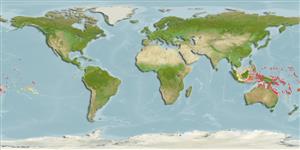>
Ovalentaria/misc (Various families in series Ovalentaria) >
Pomacentridae (Damselfishes) > Pomacentrinae
Etymology: Amphiprion: Greek, amphi = on both sides + Greek, prion, -onos = saw (Ref. 45335).
More on author: Bleeker.
Environment: milieu / climate zone / depth range / distribution range
Ecologia
marinhas associadas(os) a recifes; não migratória; intervalo de profundidade 1 - 18 m (Ref. 1602). Tropical; 10°N - 30°S
Pacific Ocean: Eastern Indonesia (Bali and Sulawesi eastward), south-eastern Philippines, Papua New Guinea, eastern Queensland, Coral Sea, Solomon Islands, Vanuatu, New Caledonia Palau and Islands of Micronesia.
Length at first maturity / Tamanho / Peso / Idade
Maturity: Lm 5.0, range 5 - 5.5 cm
Max length : 12.0 cm TL macho/indeterminado; (Ref. 9710); Idade máx. registada: 5 anos (Ref. 237)
Descrição breve
Chaves de identificação | Morfologia | Morfometria
Espinhos dorsais (total) : 10; Raios dorsais moles (total) : 16 - 18; Espinhos anais: 2; Raios anais moles: 13 - 14.
Adults inhabit lagoon and outer reef environments. Feed predominantly on planktonic copepods and algae. Oviparous, distinct pairing during breeding (Ref. 205). Eggs are demersal and adhere to the substrate (Ref. 205). Males guard and aerate the eggs (Ref. 205). Associated with the anemones: Entacmaea quadricolor (usually), Heteractis crispa (occasionally), and Heteractis magnifica (rarely) (Ref. 5911). Has been reared in captivity (Ref. 35404, 35413, 35420).
Benthic spawner. Oviparous, distinct pairing during breeding (Ref. 205). Eggs are demersal and adhere to the substrate (Ref. 205). Males guard and aerate the eggs (Ref. 205). Also Ref. 7471.
Allen, G.R., 1991. Damselfishes of the world. Mergus Publishers, Melle, Germany. 271 p. (Ref. 7247)
Categoria na Lista Vermelha da IUCN (Ref. 130435: Version 2024-1)
Ameaça para o homem
Harmless
Utilização humana
Pescarias: pescarias de subsistência; Aquário: Espécies comerciais
Ferramentas
Relatórios especiais
Descarregue XML
Fontes da internet
Estimates based on models
Preferred temperature (Ref.
123201): 25.1 - 29.3, mean 28.7 °C (based on 1672 cells).
Phylogenetic diversity index (Ref.
82804): PD
50 = 0.5000 [Uniqueness, from 0.5 = low to 2.0 = high].
Bayesian length-weight: a=0.02239 (0.01320 - 0.03796), b=3.03 (2.88 - 3.18), in cm total length, based on LWR estimates for this species & (Sub)family-body (Ref.
93245).
Nível Trófico (Ref.
69278): 2.3 ±0.0 se; based on diet studies.
Generation time: 2.1 ( na - na) years. Estimated as median ln(3)/K based on 1
growth studies.
Resiliência (Ref.
120179): Médio, tempo mínimo de duplicação da população 1,4 - 4,4 anos (K=0.53; tm=1.67; tmax=5; Fec=7,200).
Fishing Vulnerability (Ref.
59153): Low vulnerability (25 of 100).
Nutrients (Ref.
124155): Calcium = 107 [53, 172] mg/100g; Iron = 0.751 [0.457, 1.271] mg/100g; Protein = 18 [17, 19] %; Omega3 = 0.101 [0.060, 0.166] g/100g; Selenium = 22.6 [12.3, 44.2] μg/100g; VitaminA = 84.9 [20.9, 314.2] μg/100g; Zinc = 1.93 [1.30, 2.86] mg/100g (wet weight);
